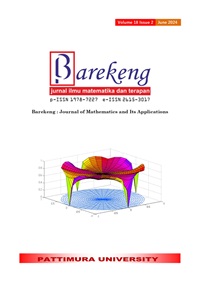MATHEMATICAL MODEL OF REPELLENT EFFECT IN DENGUE TRANSMISSION
Abstract
Dengue is a disease caused by the dengue virus, transmitted through the bite of an infected female Aedes aegypti. Dengue virus is a member of the genus Flavivirus, family Flaviviridae. Indonesia is one of the countries with the most dengue cases in Southeast Asia. Therefore, dengue transmission must be controlled to reduce the increase in dengue cases. One of the controls is by using repellents. Repellent is one of the human protection strategies to avoid mosquito bites used by spraying or smearing. This study models dengue transmission by reviewing the effect and control of repellent. A mathematical model of repellent effect and control in dengue transmission uses a SIR compartment model. The SIR model is modified by involving mosquitoes and the human population. Repellent is used in both susceptible humans, infected humans, and recovered humans. Numerical and analytical simulations are conducted to analyze the behavior of each compartment of the mosquito and human populations in dengue transmission. Analytical results show that the factors affecting the spread of infection are the transmission rate of the dengue virus and the loss of human-repellent protection. The transmission rate of dengue virus in the interval increases the infected human by 2.73%, while the rate of loss of human repellent protection in the interval increases the infected human by 0.03%. Optimal control is used to minimize the number of infected humans who do not use repellent. The results of numerical simulations on the optimal control problem show that an increase in the proportion of healthy humans who have campaign effect and use repellent regularly in the range of 14.67% can reduce infected individuals by 0.647%.
Downloads
References
M. G. Guzman, D. J. Gubler, A. Izquierdo, E. Martinez and S. B. Halstead, “Dengue Infection,” Nature Review Disease Primer, p. 16055, 2016.
M. L. Moi, Y. Ami, C.-K. Lim, Y. Suzaki, Y. Saito, K. Kitaura, M. Saijo, R. Suzuki, I. Kurane and T. Takasaki, “Formation of infectious dengue virus-antibody immune complex in vivo in marmosets (Callithrix jacchus) after passive transfer of anti-dengue virus monoclonal antibodies and infection with dengue virus,” The American Journal of Tropical Medicine and Hygiene, vol. 92, no. 2, pp. 370-376, 2015.
V. H. Ferreira-de-Lima and T. N. Lima-Camara, “Natural vertical transmission of dengue virus in Aedes aegypti and Aedes albopictus: a systematic review,” Parasites & Vectors, vol. 11, 2018.
Central for Disease Control and Prevention, “Transmission,” WHO, 2019. [Online]. Available: www.cdc.gov/dengue/transmission/index.html. [Accessed 15 September 2022].
L. R. Bowman, S. Donegan and P. J. McCall, “Is Dengue Vector Control Deficient in Effectiveness or Evidence?: Systematic Review and Meta-analysis,” PLoS Negl Tropc Dis, vol. 10, no. 3, 2016.
World Healthy Organization, “Dengue and Severe Dengue,” WHO, 2022. [Online]. Available: https://www.who.int/news-room/fact-sheets/detail/ dengue-and-severe-dengue. [Accessed 22 September 2022].
Indonesian Health Ministry, “Entering the Season Transition, the Ministry of Health Asks the Health Office to Be Wary of a Surge in Dengue Fever,” Indonesian Health Ministry, 2022. [Online]. Available: https://sehatnegeriku.kemkes.go.id/baca/umum/20220923/3741130/masuk-peralihan-musim-kemenkes-minta-dinkes-waspadai-lonjakan-dbd. [Accessed 29 September 2022].
T. A. Prasetyo, R. Saragih and D. Handayani, “Optimal Control on the Mathematical Models of Dengue Epidemic by Giving Vaccination and Repellent Strategies,” in Journal of Physics: Conference Series, 1490 012034, 2020.
Central for Disease Control and Prevention, “Vaccine Safety and Effectiveness,” WHO, 2023. [Online]. Available: https://www.cdc.gov/dengue/vaccine/parents/safety-effectiveness. [Accessed 4 August 2023].
W. H. Organization, “General Risk Assesment Models for Insecticide-trated Clothing, Skin-Applied Repellents and Household Insecticides,” WHO, 2019.
J. W. Tang, W. P. Bahnfleth, P. M. Bluyssen, G. Buonanno, J. L. Jimenez, J. Kurnitski, Y. Li, S. Miller, C. Sekhar, R. Morawska, L. C. Marr, A. K. Melikov, W. Nazaroff, P. V. Nielsen, R. Tellier, P. Wargocki and S. J. Dancer, “Dismantling myths on the airborne transmission of severe acute respiratory syndrome coronavirus-2 (SARS-CoV-2),” The Journal of Hospital Infection, vol. 110, pp. 89-96, 2021.
N. C. Achaiah, S. B. Subbarajasetty and R. M. Shetty, “R0 and Re of COVID-19: Can We Predict When the Pandemic Outbreak will be Contained?,” Indian Journal of Critical Care Medicine, vol. 24, no. 11, p. 1125, 2020.
G. O. Fosu, E. Akweittey and A. Adu-Sackey, “Next-Generation Matrices and Basic Reproductive Numbers for All Phases of The Coronavirus Disease,” Open Journal of Mathematical Sciences, vol. 4, no. 1, pp. 261-272, 2020.
N. A. Lestari, Sutimin, S. Khabibah, R. H. S. Utomo, R. Herdiana and A. H. Permatasari, “Local Stability Analysis for Tuberculosis Epidemic Model with Different Infection Stages and Treatments,” in Journal of Physics: Conference Series, 1943 012120, 2020.
F. Brauer, C. Castillo-Chavez and Z. Feng, “Endemic Disease Models,” Mathematical Models in Epidemiology, vol. 69, pp. 63-116, 2019.
Copyright (c) 2024 Dewi Handayani, Audri Utami Gunadi, Ria Nurlita Rachmawati

This work is licensed under a Creative Commons Attribution-ShareAlike 4.0 International License.
Authors who publish with this Journal agree to the following terms:
- Author retain copyright and grant the journal right of first publication with the work simultaneously licensed under a creative commons attribution license that allow others to share the work within an acknowledgement of the work’s authorship and initial publication of this journal.
- Authors are able to enter into separate, additional contractual arrangement for the non-exclusive distribution of the journal’s published version of the work (e.g. acknowledgement of its initial publication in this journal).
- Authors are permitted and encouraged to post their work online (e.g. in institutional repositories or on their websites) prior to and during the submission process, as it can lead to productive exchanges, as well as earlier and greater citation of published works.






1.gif)



